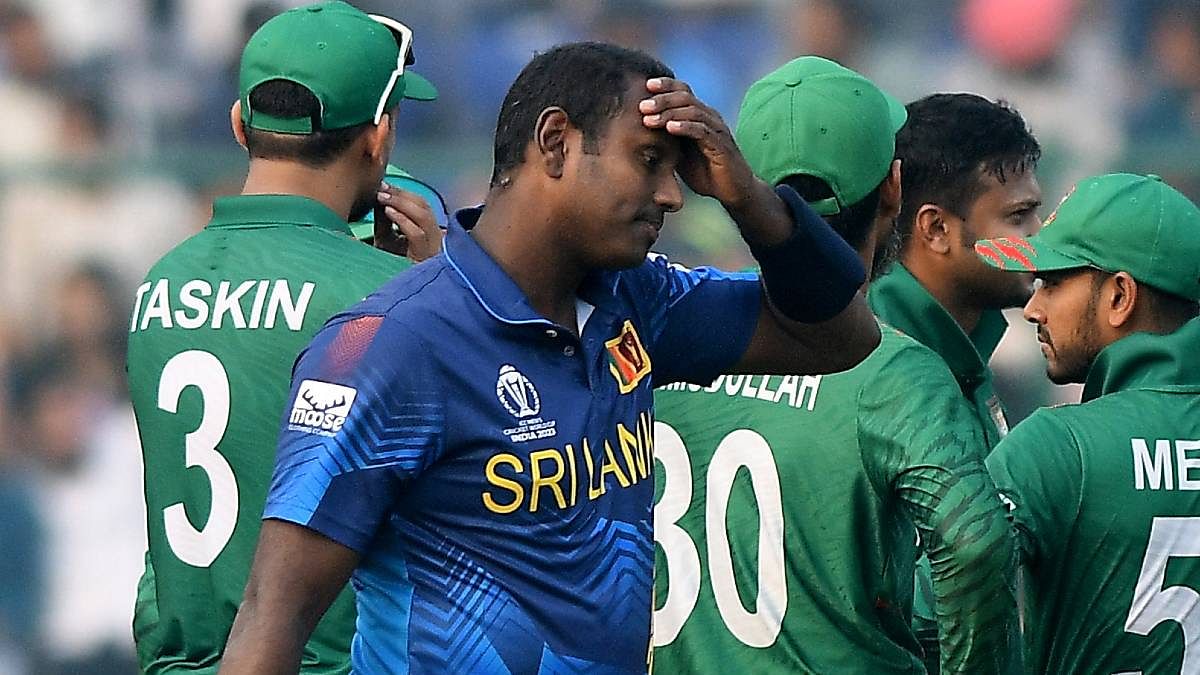New Delhi: Former Sri Lanka captain Angelo Mathews achieved a unique feat in international cricket Monday — he became the first batter to face a ‘timed-out’ dismissal.
During Sri Lanka’s World Cup match against Bangladesh in Delhi, Mathews failed to reach the pitch within the required time — after the dismissal of a player, the next batter is supposed to face the ball within 2 minutes in World Cup matches, and 3 minutes otherwise.
Although Mathews had initially entered the ground, he encountered helmet issues that necessitated a replacement, causing the deadline to run out. Bangladesh skipper Shakib Al decided to appeal for dismissal by the ‘time-out’ rule, and it was accepted.
Such a dismissal, however, won’t land in the stats of the bowler on the pitch, as usually happens.
Mathews was clearly displeased about his dismissal and even discussed the decision with umpire Marias Erasmus and Shakib before walking out.
As a controversy erupted, with the decision starting a debate on social media, former South Africa pacer Dale Steyn weighed in on Twitter, saying, “Well, that wasn’t cool ⏰” and criticising Bangladesh captain Shakib for his appeal.
The laws of cricket are administered by the Marylebone Cricket Club (MCC), the world’s “most active cricket club” and the owner of the Lord’s ground.
The timeout law is Rule 40.1 of the code governing cricket.
Clause 40.1.1 states that “after the fall of a wicket or the retirement of a batter, the incoming batter must, unless time has been called, be ready to receive the ball, or for the other batter to be ready to receive the next ball within three minutes of the dismissal or retirement”.
“If this requirement is not met, the incoming batter will be out, timed out,” it says.
The subsequent clause, 40.1.2, says that in “the event of an extended delay in which no batter comes to the wicket, the umpires shall adopt the procedure of law 16.3 (umpires awarding a match)”.
“For the purposes of that law, the start of the action shall be taken as the expiry of the three minutes referred to above,” it adds.
The timed-out rule was introduced in 1980, and initially granted the next batsman two minutes to take position. It was extended to three minutes in 2000.
The practice of a fixed interval between two batters taking position dates further back. The first printed cricket laws in 1775 called on umpires to allow two minutes for the next player to come in after one was out.
Former India captain Sourav Ganguly had a close call with the timed-out rule in a 2006-07 series against South Africa.
Also Read: Cricket, club & country. The challenge of nationalism, politics, emotion
The Heygate incident of 1919
In 1919, during a County Championship match between Sussex and Somerset at Taunton, UK, Sussex cricketer Harold Heygate was declared timed out by umpire Alfred Street.
Heygate had reportedly only decided to bat after persuasion, and “walked very slowly towards the stumps”, leading to an appeal from the Somerset captain, according to a piece on the website of Sussex Cricket Museum.
The decision created much controversy as Heygate had just returned from serving in the First World War and was wounded.
After an investigation, the MCC said the umpire’s decision was correct. However, they suggested marking the batsman as “absent”, as it is reflected in the 1920 edition of Wisden Cricketers’ Almanack.
In the 2006-2007 series between India and South Africa, during the third test at Cape Town’s Newlands cricket ground, India had a close brush with the rule.
On account of time spent off the field while fielding in an earlier innings, Sachin Tendulkar couldn’t step out onto the field in his position as No. 4 when the Indian openers were dismissed by the second over.
A rushed arrangement saw Sourav Ganguly enter the field. There was a six-minute delay, but South African captain Graeme Smith did not appeal for a timed-out dismissal.
During the 2023 Ashes series, in the second Test, Australian spinner Nathan Lyon injured his calf while fielding. In the Australian second innings, Lyon batted as the final player. To avoid getting dismissed due to a time-out, he positioned himself closer to the field.
(Edited by Sunanda Ranjan)
Also Read: Spinners or pacers—Who are winning the 2023 World Cup?

